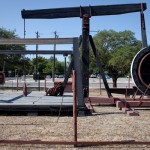Where the Keystone XL Pipeline Stalled: the Sands of Nebraska
Just what happened that led to the delay of the Keystone XL pipeline? Views are mixed, not surprisingly, but as Toronto’s Globe and Mail reports, a real sticking point, in addition to those of ideology or politics, was simply geography.
The route of the proposed pipeline would have gone from Canada right through the “boiling sands” of Nebraska to refineries in Texas. The paper reports that these boiling sands are areas of sandy soil where the ground is so thin that “groundwater can bubble up through it to the surface.” Nebraska’s boiling sands in the Sand Hills region sit over a giant freshwater aquifer called the Ogallala.
So, how do you dig trenches and anchor the pipeline in such an environmentally sensitive area? It’s an engineering question the company behind the pipeline never got around to dealing with, the paper reports:
“Keystone XL was the first major pipeline to confront a country that had suddenly turned a sharp eye on the oil industry. The BP spill had erupted amidst still-simmering concerns about global warming – and in the following months, a series of pipeline spills into important U.S. rivers made headlines.
Against that backdrop, Nebraska’s boiling sands transformed from an engineering challenge into a political and social challenge – one that TransCanada, and the industry in general, was ill-equipped to handle.”
Today comes news from the company behind the Keystone XL pipeline, TransCanada, that they may start construction on the pipeline within months. A spokesman told the The Canadian Press today that the recent bill passed by the U.S. Congress and signed by the president to extend the payroll tax cut and force a decision on the pipeline within sixty days speeds up the construction process.
“This bill allows construction work to take place in five of the six states where the route is confirmed,” TransCanada spokesman Shawn Howard.
You’ll notice he said “where the route is confirmed.” There’s one section of the pipeline that wouldn’t be built yet, if construction begins in 2012 — sixty miles of the pipeline that go through the sands of Nebraska. The TransCanada spokesman says that this is the only section that needs to get worked out, as the rest of the pipeline has virtually been approved.
“It’s not overriding some environmental review that has to take place. It’s not changing that review. This bill was carefully crafted, it respected that,” he told the paper.


